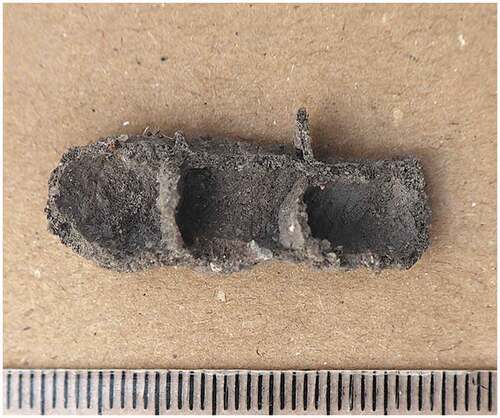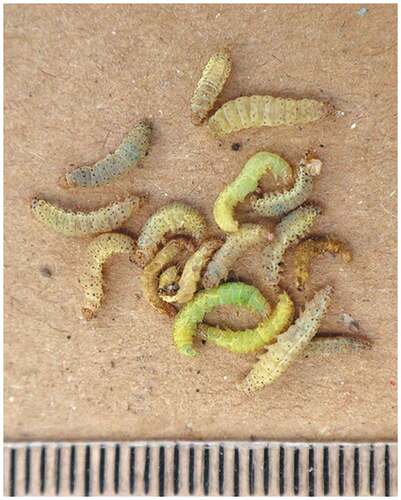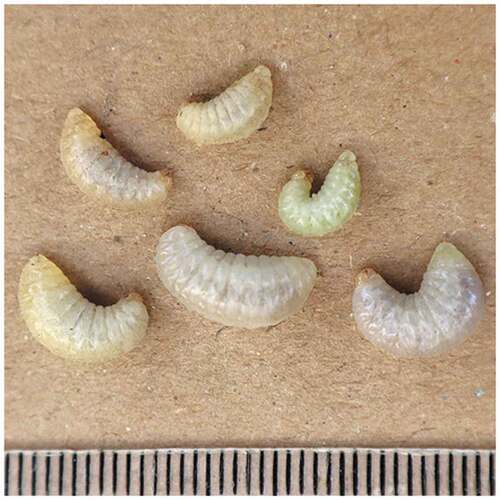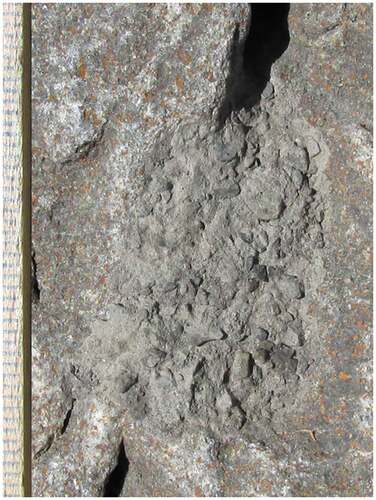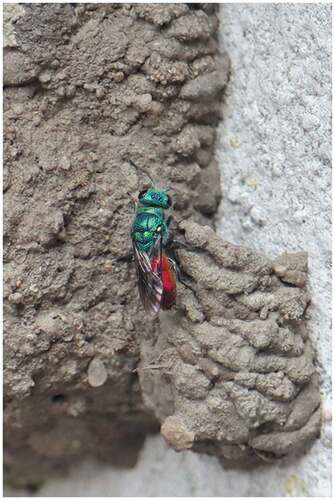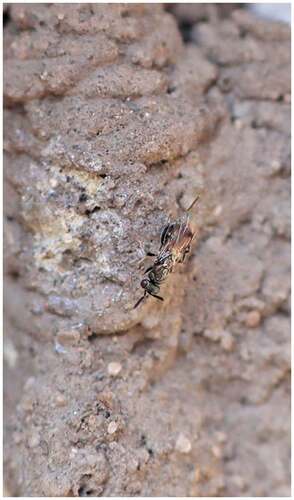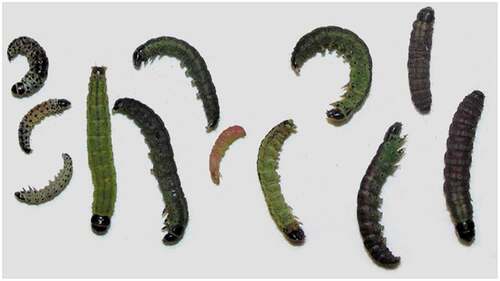Abstract
Two nests of Ancistrocerus oviventris (Wesmael, 1836) are described. One nest from Poland was attached to a concrete fence and consisted of 10 mud cells. The second nest from the Crimea was attached to a stone and consisted of three mud cells covered with an additional layer of mud and gravel particles. Females provisioned their cells with moth caterpillars of the families Crambidae and Depressariidae; 5–13 caterpillars were stored per cell. A chalcid wasp Monodontomerus aeneus (Fonscolombe, 1832) was recorded as a parasitoid while a cuckoo wasp Chrysis rutiliventris Abeille, 1879 and a sarcophagid fly Amobia sp. were recorded as kleptoparasites.
Introduction
Ancistrocerus oviventris (Wesmael, 1836) is known from a large part of the Palaearctic region (Antropov & Fateryga Citation2017). In Central Europe, it is found in mountainous areas up to 2000 m above sea level (von Schulthess Rechberg Citation1887–1897). This species uses stones and walls of buildings, especially their crevices, as nesting sites and builds nests that resemble those of the bee Megachile parietina (Geoffroy, 1785) (Ferton Citation1895; Borries Citation1897; Adlerz Citation1907; Roman Citation1907; Mjöberg Citation1909; Micheli Citation1930; Nielsen Citation1932; Bonelli Citation1970). These nests consist of several (up to 14) constructed mud cells covered with an additional layer of mud and gravel particles. The nests are provisioned with moth caterpillars (Ferton Citation1895; Nielsen Citation1932; Bonelli Citation1970), particularly of the family Tortricidae (Lepidoptera) (Mjöberg Citation1909; Micheli Citation1930). Known kleptoparasites are cuckoo wasps of the Chrysis ignita-group (Hymenoptera: Chrysididae) such as C. ignita (Linnaeus, 1758), C. ruddii Schuckard, 1837, C. impressa Schenck, 1856 (Micheli Citation1930; Nielsen Citation1932; van Lith Citation1953; Bonelli Citation1970), and possibly also C. clarinicollis Linsenmaier, 1951 (Paukkunen et al. Citation2015). Melittobia acasta (Walker, 1839) (Hymenoptera: Eulophidae) was recorded as a parasitoid (Micheli Citation1930). The aim of this study is to supplement the existing data on the nesting biology of A. oviventris with the description of two nests and their contents.
Material and methods
The first nest was found in the town of Kowalewo Pomorskie in Poland (53°10’05”N, 18°52’15”E) and observed on 9–22 June 2022 during sunny and warm days. The site in Kowalewo Pomorskie comprised a backyard surrounded by fallow land overgrown with herbaceous vegetation (see Olszewski et al. Citation2021 for details). Another nest was found in the Kanaka Reserve in the Crimea (44°46′28″N, 34°37′01″E) on 8 June 2015. This site was a stony beach at the coast of the Black Sea. Species identification was done after catching females with an entomological net. Nesting biology was analysed based on direct observations and on-site notes. Photographs were taken with a Canon EOS M50 and a Canon PowerShot SX160 IS cameras; in addition, a Raynox M-250 macro converter was used. The contents of the cells were collected after detaching the nests from the substrates on 22 June in 2022 and 8 June in 2015.
Results
The nest from Kowalewo Pomorskie consisted of 10 mud cells placed in a milled recess on a concrete fence (). Nine cells were arranged in three rows of three cells each (); the 10th cell was incomplete and corresponded to the beginning of the fourth row (the nest was not finished). The female of A. oviventris observed at this nest was usually building a new cell from mud (soil mixed with regurgitated water and saliva) in the afternoon (until approximately 4 pm) so that the provisioning happened mostly in the morning. After a cell had been sealed with a mud plug, the female constructed the next cell in the same row or began a new row of cells. The cells were 7–8 mm in inner diameter and 9–10 mm in inner length. The female provisioned cells with moth caterpillars of the subfamily Crambinae (Lepidoptera: Crambidae) (), 6–13 caterpillars were stored per cell depending on their size (10 on average). The female carried them to the nest by flight at intervals of about 12–25 min. While the female was away from the nest, a cuckoo wasp belonging to the Chrysis ignita-group was observed entering a cell (), but its progeny were not found in the nest. During the nest inspection on 22 June 2022, a total of six A. oviventris larvae at different stages of development were collected from six cells (). Three remaining complete cells were infested with numerous pupae and imagoes of Monodontomerus aeneus (Fonscolombe, 1832) (Hymenoptera: Torymidae) ().
Figure 9. Pupae of M. aeneus from the same nest as preceding. Ruler gradation (in , , , and ) = 1 mm.
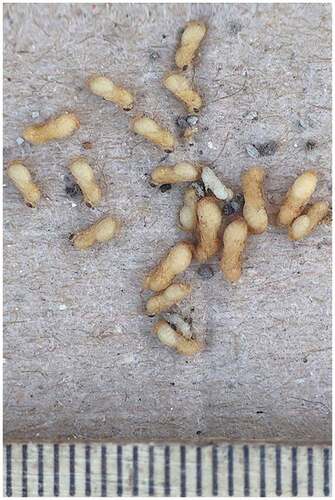
The nest from the Kanaka Reserve was located in a crevice of a medium sized stone. This nest contained three irregularly arranged mud cells covered with an additional layer of mud and gravel particles (). The female of A. oviventris was observed only in the moment when she finished this additional covering. The cells were 7 mm in inner diameter and 14–20 mm in inner length. The first (the most inner) cell contained four maggots of a kleptoparasitic fly Amobia sp. (Diptera: Sarcophagidae). The second cell contained seven stored moth caterpillars, a dead wasp egg, and a young larva of a cuckoo wasp (Hymenoptera: Chrysididae). The third cell contained five stored caterpillars and a wasp egg. The caterpillars were of the family Depressariidae (Lepidoptera) with predomination of two species tentatively identified as Agonopterix pallorella (Zeller, 1839) and Exaeretia stramentella (Eversmann, 1844) (). The cuckoo wasp reared from the second cell was identified as Chrysis rutiliventris Abeille, 1879.
Discussion
The results of the presented research are largely consistent with the literature. Particularly, the structure of the nests of A. oviventris observed in this study corresponds to earlier descriptions (e.g., Mjöberg Citation1909; Micheli Citation1930; Nielsen Citation1932). Our data, however, specified the taxonomic composition of the prey of this species: previous researchers suggested that it was (unspecified) moth caterpillars (Ferton Citation1895; Nielsen Citation1932; Bonelli Citation1970) or caterpillars of the family Tortricidae (Mjöberg Citation1909; Micheli Citation1930) while we found them belonging to Crambidae and Depressariidae. Supposedly, the earlier researchers merely did not separate two latter families from the family Tortricidae in the broad sense. However, it is also highly possible that A. oviventris can hunt for the true Tortricidae as well. When analysing the prey of A. oviventris, we can also suppose that females of this species hunt for caterpillars at the grass level. Both tentative prey species identified from the Crimea, A. pallorella and E. stramentella, are confined to herbaceous Asteraceae: Centaurea spp. and Tanacetum spp., respectively (V.V. Savchuk, personal communication). Reports of beetle larvae (both Curculionidae and Chrysomelidae) as the provision of A. oviventris by Borries (Citation1897) and Blüthgen (Citation1961) seem erroneous due to misidentified wasps.
Ancistrocerus oviventris was reported as a host of C. rutiliventris by Morgan (Citation1984). However, this species of cuckoo wasps is replaced in the Great Britain by the closely related C. vanlithi Linsenmaier, 1959 (P. Rosa, personal communication). Therefore, the report by Morgan (Citation1984) referred to C. vanlithi but not to C. rutiliventris. Thus, our record of the host-parasite relationships between A. oviventris and C. rutiliventris is actually new. Since the larva of this cuckoo wasp apparently killed the host egg and then was observed feeding on the stored provision, it can be assumed that this species acts as a kleptoparasite (= inquiline) (see the classification in Martynova & Fateryga Citation2015).
In this study, we recorded Amobia sp. and M. aeneus for the first time as brood parasites of A. oviventris. The first species fed mostly on the prey and thus, similarly to C. rutiliventris, is a kleptoparasite. Monodontomerus aeneus fed on the host prepupae and thus is a parasitoid. In the literature to date, M. aeneus has apparently only been mentioned among parasitoids of the bees in the families Apidae and Megachilidae (Grissell Citation2007).
Acknowledgements
We would like to thank Zofia and Edward Olszewski for the possibility of conducting research in Kowalewo Pomorskie. We are very grateful to Jarosław Buszko (Nicolaus Copernicus University) for the identification of the subfamily Crambinae and Bogdan Wiśniowski (University of Rzeszów) for the identification of M. aeneus. We also would like to thank Paolo Rosa (University of Mons) and Kate V. Martynova (Schmalhausen Institute of Zoology of the National Academy of Sciences of Ukraine) for their help in the identification of the cuckoo wasps. We are very grateful to Vladimir V. Savchuk (Feodosiya) for the identification of the family Depressariidae. We are also grateful to Villu Soon and two anonymous reviewers for their helpful comments. The work of the second author was a part of the State research project No. 121032300023-7.
Disclosure statement
No potential conflict of interest was reported by the author(s).
References
- Adlerz G. 1907. Iakttagelser öfver solitära getinger. Arkiv för Zoologi 3(17):1–64.
- Antropov AV, Fateryga AV. 2017. Family Vespidae. In: Lelej AS, Proshchalykin MY, Loktionov VM, editors. Annotated catalogue of the Hymenoptera of Russia. Vol. 1. Symphyta and Apocrita: Aculeata. Proceedings of the Zoological Institute RAS, Supplement 6. Saint Petersburg: Zoological Institute RAS. pp. 175–196. DOI: 10.31610/trudyzin/2017.supl.6.5.
- Blüthgen P. 1961. Die Faltenwespen Mitteleuropas (Hymenoptera, Diploptera). Abhandlungen der Deutschen Akademie der Wissenschaften zu Berlin. Klasse für Chemie, Geologie und Biologie 1961(2):1–252.
- Bonelli B. 1970. Osservazioni biologiche sugli Imenotteri melliferi e predatori della Val di Fiemme. XXX. Bollettino dell’Istituto di Entomologia della Università degli Studi di Bologna 29: 155–163 + pl. I.
- Borries H. 1897. Om Redebygningen hos Ancistrocerus oviventris Wesm. Videnskabelige Meddelelser fra den Naturhistoriske Forening i Kjöbenhavn 1897:160–163.
- Ferton C. 1895. Observations sur l’instinct de quelques Hyménoptères du genre Odynerus Latreille. Actes de la Société Linnéenne de Bordeaux 48:219–230.
- Grissell EE. 2007. Torymidae (Hymenoptera: Chalcidoidea) associated with bees (Apoidea), with a list of chalcidoid bee parasitoids. Journal of Hymenoptera Research 16(2):234–265.
- Martynova KV, Fateryga AV. 2015. Chrysidid wasps (Hymenoptera, Chrysididae) – Parasites of eumenine wasps (Hymenoptera, Vespidae: Eumeninae) in Crimea. Entomological Review 95(4):472–485. DOI: 10.1134/S0013873815040090.
- Micheli L. 1930. Note biologiche e morfologiche sugli Imenotteri (contributo 2°). Memorie della Società Entomologica Italiana 9:46–66.
- Mjöberg E. 1909. Biologiska iakttagelser över Odynerus oviventris Wes. Arkiv för Zoologi 5(7):1–8.
- Morgan D. 1984. Cuckoo-wasps. Hymenoptera, Chrysididae. In: Fitton MG, Barnard PC, editors. Handbooks for the identification of British insects. Vol. 6, part 5. London: Royal Entomological Society of London. pp. 1–37.
- Nielsen ET. 1932. Sur les habitudes des Hyménoptères aculéates solitaires II (Vespidae, Chrysididae, Sapygidae et Mutillidae). Entomologiske Meddelelser 18:84–174.
- Olszewski P, Bogusch P, Szpila K. 2021. Life history of Oxybelus variegatus Wesmael, 1852 (Hymenoptera: Crabronidae) with a description of the mature larva. Insects 12(2):100. DOI: 10.3390/insects12020100.
- Paukkunen J, Berg A, Soon V, Ødegaard F, Rosa P. 2015. An illustrated key to the cuckoo wasps (Hymenoptera, Chrysididae) of the Nordic and Baltic countries, with description of a new species. ZooKeys 548:1–116. DOI: 10.3897/zookeys.548.6164.
- Roman A. 1907. Två nya stekelbon. Entomologisk Tidskrift 28(2–3):107–108.
- van Lith JP. 1953. De Nederlandse metselwespen. Enkele Aanvullende Gegevens over Verspreiding En Biologie. De Levende Natuur 56(12):231–233.
- von Schulthess Rechberg A. 1887–1897. Fauna insectorum Helvetiae. Hymenoptera. Fam. Diploptera Latr. (Vespida aut.). Schaffhausen: F. Rothermel. 126 + iv pp. + 2 pls.


